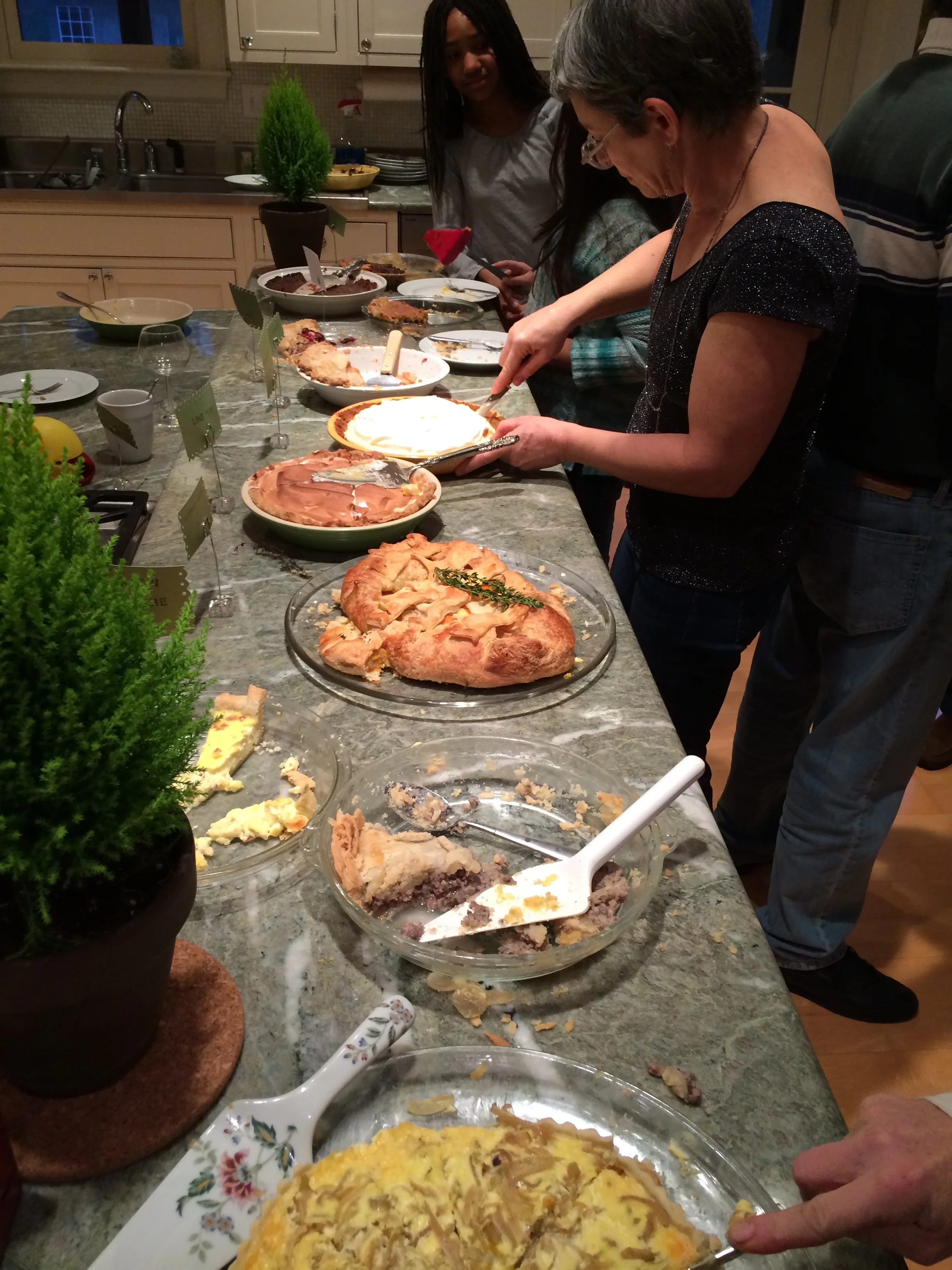Charcuterie & fromage
/My Bride's mother & father came and stayed with us for a few weeks this month, and our house has been full of food, and hugs, and love. The kids especially love seeing their grandparents (of course). And with the weather being mostly so frigid, we've stayed in doors and around the kitchen and fireplace quite a lot.
Last weekend, we decided we'd go into our freezer full of pig, and do a little charcuterie. I was also inspired by our recent trip up to Vermont to make a bit more cheese. We figured we'd have a whole shut-in weekend of old-time preserving.
We started out making Longanisa - a Filipino sausage much like a Portuguese linguiça - sweet and tart and well seasoned. Grinding and stuffing the sausage was a whole family event, and took most of an afternoon, and many, many sausage jokes.
My Bride's people are not tall, and needed proper sausage stuffing leverage. Fortunately, we were prepared.
The pork was really beautiful - a great ratio of fat to meat. With the leftovers, I was able to put up a few pounds of chorizo. (Made from our pig, Honeydew, not Chorizo. Which made the Critter laugh. We had asked the butcher to label all of the meat so we'd be able to keep track of which pig we were eating. Honeydew's packages are all written in blue, and Chorizo's all in red.)
I used the same chorizo recipe that I've used in the past. I love this recipe - it's easy to bag & freeze pre-portioned amounts of meat. I don't bother casing it - I always use this for burritos or huevos rancheros anyway. One of my favorite breakfasts in the word.
I also had pulled out two beautiful joints that the butcher had set aside for coppa. I've never made coppa before, but after describing the basic cuts I wanted to make sure we got (plenty of back bacon, three prosciuttos, etc), I told Maureen, the awesome partner at our butcher to just cut the pig how she felt best.
When I pulled these boneless joints out - cut from the meaty part of the back of the neck on the pig, the marbling was absolutely gorgeous. That's right - marbling on a cut of pork. The peanut-rich diet for our pigs - along with the forage from the forested run they had - clearly had turned into some beautiful meat.
I laid the joints out and rubbed them down with a combination of salt, pepper, fennel, garlic, and a few crushed juniper berries.
Well actually, I employed child labor to do the hard part.
Nothing like a little handling a little raw meat in your superhero pajamas, ammiright?
(Note, that's a bowl of chorizo in the foreground, waiting to be bagged)
Coppa is cured by letting it rest for a bit (I gave it 24 hours post-rub in the refrigerator) and then casing it in a beef bung and hanging it to finish. This will take about 4-6 weeks, and it'll lose about a third of its weight as the meat dries & cures, and the fat becomes silky.
I'd never worked with a beef bung before. When you order one on Amazon, it comes in a plastic tube as a hardened, salty, fairly smelly little ball. An hour or so of soaking later, and you end up with a pliable, stretchy & tough natural casing that will wrap around a 6" diameter piece of meat. With a bit of love and effort.
I've hung these in my cellar which is a constant 55 degrees or so, and steady humidity. I keep going downstairs in the evening to check on them. They're tightening up already, and I can smell the faintly peppery smell of the cure.
I can not wait to get these onto my slicer.
While I had the components (and chil-dout, I pulled out a large piece of Honeydew's belly as well. (See? Using their names to talk about eating them stops getting weird after a few times, doesn't it? Or maybe it gets weirder. I'm not sure.)
This meat just continues to amaze me. Absolutely beautiful. We've had good pork in the past, but nothing to compare to this. I had to cut this piece of belly in half to work with it.
I used my butcher's recipe - he charges about $30 per pound for his cured pancetta, but he gave me the recipe for free. Probably figuring not to many of his customers are daft enough to do this. Plus, he's just cool that way.
These get sealed in a food-saver vacuum bag with salt, a little brown sugar, garlic, rosemary, and pepper, and a couple of those crushed juniper berries and put into the fridge for a week or so before I'll roll them and hang them. to cure. Again - 6 or 7 weeks, and I'll end up with pancetta that'll blow your mind.
Cheese
The next day, we moved on to cheese.
I had been running through my cheddar a bit lately, and hadn't put any up to cure lately. What I found from our first attempts is that it takes a year or so to really cure to the point you're going to enjoy eating it. Before that, it tasted young and curdy. More time = more sharpness.
So I knew I wanted to put up a couple more wheels. I also wanted to try out a new recipe, though, and expand our repertoire a little further.
The larger pot is my cheddar, resting and waiting to curdle. In the smaller, white pot is goat's milk. The first batch of chèvre I made is hanging on the rack in the background.
Goat's milk chèvre is incredibly easy to make, it turns out. There are only 3 ingredients:
- Goat's milk (well, duh).
- Citric acid
- Salt
Our local Whole Foods carries goat's milk, and the rest I got on the internet. Within an hour, I had a really excellent cheese that was declared acceptable & quickly devoured by the family.
I spread mine on a toasted bread with a little drizzle of honey. Excellent.
Yeah. Winter days like these are pretty much my favorite.






















